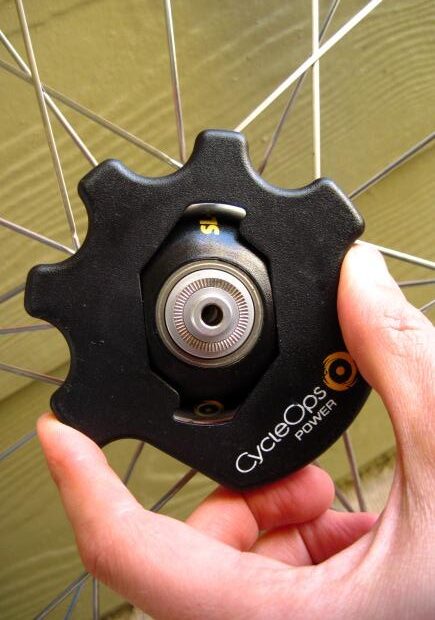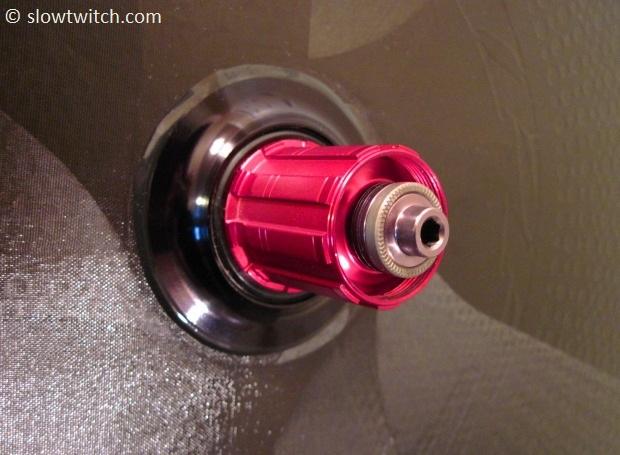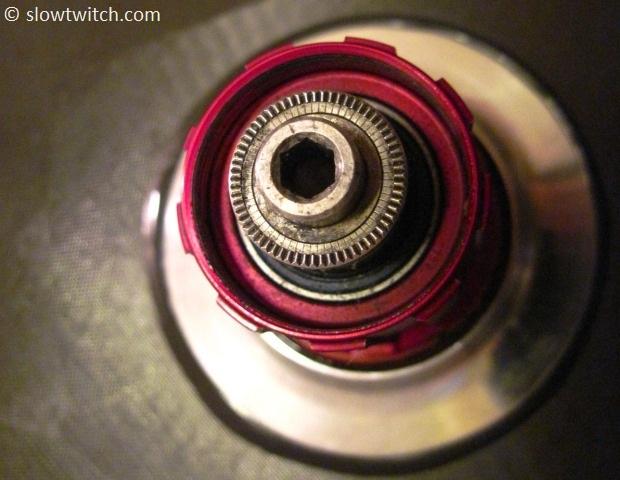Hub How-To – Dura Ace 7900
This article continues our How-To series on rear hub service. Thus far, we’ve covered the Zipp 182, Zipp 188, Powertap SL+ series, and Powertap G3 series (linked at the bottom of this page).
Shimano is well-known for staying with a traditional, time-tested, and reliable hub design. While no manufacturer is entirely free of defects, Shimano’s hubs have earned a reputation of being durable, but not the lightest on the market.
The key to their design is the fact that it relies on adjustable cup-and-cone, angular contact bearings. The cup-and-cone design of the races cradles the ball bearings, dealing with lateral forces better than radial bearings (for example, in the event of a misadjusted hub or hard cornering). The beauty of this design is that the ball bearings can be removed individually, cleaned, re-greased, and reinstalled. In most Shimano hubs, this can be done with inexpensive cone wrenches (rather than a bearing press kit for cartridge bearing hubs).
The 7900-series Dura Ace hubs brought on a few notable changes to the traditional design; let’s see how they work.
Getting Started
The wheel for today’s demo is a 2012 Shimano C50 clincher rear wheel. It doesn’t need to be serviced, but we’ll do it anyway.
The both the left and right axle ends fit a 5mm allen wrench.

Insert one in to each end and turn them against each other (standard right hand threads). Remove the left side threaded end cap and washer:

Next, pull off the plastic bearing adjuster (it will pull right off):

Note that this adjuster is keyed. Also note that the axle in the background has a similar shape. When you line the two flat parts up, the plastic adjuster goes all the way on the axle. That flat portion keeps everything locked together, so you cannot adjust the hub preload any longer.
To use the plastic piece to adjust the hub, all you do is turn it in any other orientation and press it back on to the axle. As long as the flat parts don’t line up, you can’t push the adjuster on all the way. In that case, the small splines lock together, and you push the tool about halfway on (it will be a loose fit). Keep your 5mm hex wrench in the axle, and unthread the left side cone with the adjuster tool:

Next, remove the left side cone:

Now, slide the axle out of the hub’s right side (not pictured).
Both the left and right side bearings have rubber shields over them. You can remove them with a flat-headed screw driver. Keep in mind that these rubber shields are NOT identical, so you want to keep track of which is which.

The left side bearings are held together with a retainer. The drive side bearings are loose balls. DO NOT LOSE THEM! This hub has 13 in the drive side.

I put all of the bearings into a small container (like a used jar or medicine bottle) to soak in some solvent while I do the rest of the hub service. I prefer to use something that will not leave behind a residue, such as 90% isopropyl alcohol.

Next, we’re really going to go the extra mile and do the full freehub service. Shimano generally does not recommend doing this. Similar to most manufacturers, they recommend that you replace the freehub when it goes bad. With Shimano, that is actually not a bad deal, because each freehub will generally last you a number of years, rather than months. I’ve had a handful of Shimano hubs in my day, so I thought it prudent to just buy the specialty tool that allows for performing service, which we’ll get in to later.
The entire drive mechanism is housed inside the freehub – loose bearings, pawls, grease, and the whole nine yards. First, we need to remove it from the hub. This requires a big-boy 14mm allen wrench. My set of 3/8” drive allen sockets only went up to 10mm, so I bought 1/2" drive 12 and 14mm separately.

Unthread the main bolt and remove the freehub.

This is when we break out the fun stuff – the Morningstar Freehub Buddy. This little gem is a grease purging tool that fits most loose-ball-bearing freehubs, such as Shimano and Formula (Formula makes a lot of OEM hubs, such as SRAM X-7 and X-9, the lower end Salsa Mukluk ‘fat bike’ rear hub, and anything with a steel freehub).

This tool must be used with the Morningstar ‘freehub soup’ grease, which comes in a special syringe. The syringe threads straight into the tool, and you press the tool into your freehub:

Make double sure that the tool is pressed all the way in – firmly. The two o-rings in the tool trap grease into a channel, so that the grease can be forced through a tiny space in the freehub. All we’re doing is purging with new grease – similar to the regular service you must do to Speedplay pedals. I’ve seen some people use this tool to first push solvent through the freehub, then water, and finally grease. I’m personally not a fan of this procedure because it can trap solvent or water inside the freehub (which is NOT good news for the grease you’re eventually going to put in).
The grease capacity of these freehubs is rather small. The grease syringe has markings on it to show you exactly how many CCs of grease you’re injecting. Because my hub is already in great shape, I only needed 4 CCs. If you need to do a full purge, I doubt you’d need more than six.

Once you’re purged the freehub, wipe off the excess grease and remove the Freehub Buddy.
Next, put a small amount of grease on the freehub threads and splines, and thread the freehub back on (not pictured). I don’t know the exact torque spec, but it should be pretty snug; you can gauge that based on how difficult it was to remove in the first place.
Now it is time to reinstall the ball bearings. Remove them from the solvent bath and wipe them off with a clean rag. I install the drive side bearings first, so the non-drive side retainer has extra time to dry out. Put down a layer of grease in the freehub cone, and start installing your bearings one-by-one:

The layer of grease you put down first will help keep the bearings in place so you don’t lose one.
After the bearings are in, press the drive side shield back in place. This does NOT need to be smashed down very hard (that can restrict bearing movement). Just push it in to place. Next, cover the bearings in grease, and don’t be shy. I used Phil Wood waterproof grease, but you can generally get away with any standard shop or marine grease.

After you’re done on the drive side, repeat the procedure on the non-drive side. The only difference is that the non-drive side bearing shield has a more pronounced “home” – you can feel when it finds its proper resting place.
Once the left side bearings, grease, and shield are in, slide the axle back into the right side of the hub.

At this point, we’re almost done. We have clean bearings, fresh grease, and a super-slick freehub. Now comes the subjective part of setting the preload. First, thread your cone back on to the axle. What we’re shooting for is a situation of “no play” when the wheel is clamped into the frame. With Shimano hubs (but not all hubs), the tightness of the quick release affects the bearing preload. The tighter the quick release, the tighter the preload. That being the case, I shoot for a TINY bit of play when the wheel is out of the bike, and “no play” when the wheel is clamped in with an average QR tightness.
I’ve found that the best way to do this is trial-and-error. For older-style Shimano hubs, I have a neat tool that allows you to perfect this with the wheel out of the bike, but that’s for another demo. With this 7900 hub, I thread the cone down little by little, and push the axle back and forth (left-to-right) with my left and right hands.

When the preload gets tighter, it can become difficult to thread the cone by hand. When that happens, use the handy plastic adjuster tool, as we discussed during hub disassembly. When you have the preload where you want it, push the adjuster all the way on (you must line up the flat part with the axle), and reinstall your washer and end cap.
Once the hub is all back together, I do the ‘bike check’. Put the wheel in your bike and tighten the quick release skewer. Next, grab the edge of the rim and try to wiggle it left-to-right.

If you did it properly, there should be no play, and the wheel will spin freely. If you misadjusted it, remove the end cap, make a small adjustment to the preload, and try again.
Most other Shimano hubs use a threaded steel axle, instead of this lightweight aluminum design. Also, most others require cone wrenches to adjust the lock nuts and – you guessed it – cones. In some ways, Shimano has simplified the design, requiring only 5mm allen keys for basic service. If you’ve been riding your Shimano hubs for a couple seasons and haven’t done any work on them, it is probably a good idea to do half of my service procedure (everything except freehub removal). This will get you about 80% of the way there, and extend the life of your hub. If you ride the hub for a few more years and the freehub goes bad, you can simply replace the entire unit with a new one.
—
All images © Greg Kopecky / slowtwitch.com








Start the discussion at forum.slowtwitch.com